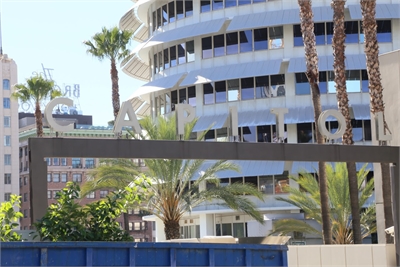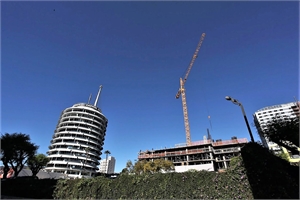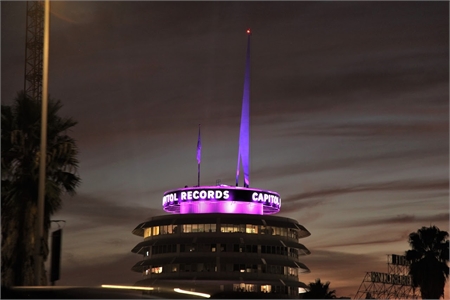The Capitol of Hollywood
The Capitol of Hollywood

When you think of Hollywood, the Hollywood Sign stands out as the landmark recognized around the world. But since its completion in 1956, the Capitol Records Building has become an iconic symbol of Hollywood and its culture of entertainment. The first circular office building in the world was designed by Welton Becket and resembles a stack of records topped by a spindle. Over the years, the building has been featured in dozens of films, in some cases crashing to the ground in earthquakes and volcano eruptions, although ironically, it cannot be seismically retrofitted. And yes, they still light up the famous Capitol “Christmas Tree” at the top of the building each Holiday season.
This year, the company is celebrating its 75th anniversary which was kicked off on Tuesday, November 15th when Capitol became the first record company to receive a star of recognition from the Hollywood Chamber of Commerce. The uniquely large star was installed in front of the landmark Capitol Tower and adjacent to the equally famous Hollywood Walk of Fame.
A little known fact is that the red light at the top of the spindle on the roof actually blinks in Morse code, normally “Hollywood” but “Capitol 50” for their 50th anniversary and now “Capitol 75” for the next 12 months. Over that period, several music, film and literary projects will be presented including The Capitol Records 75th Anniversary Collection, vinyl reissues of 75 specially selected albums from artists ranging from Frank Sinatra and Nat King Cole to The Beatles and Foo Fighters. There will also be a comprehensive photo and essay book chronicling the label’s history from 1942 through now, published by Taschen. In addition, a Capitol Records Docuseries Produced by Nigel Sinclair of Whitehorse Pictures (The Beatles: Eight Days A Week – The Touring Years) is planned to be released in the autumn of 2017. Each episode will be directed by a past or present-day Capitol artist to tell some of the many stories that have taken place throughout its 75year history as one of the world’s premiere music companies.
It will also tell the story of America’s love affair with popular music and explore how Capitol’s artists and their music helped shape social movements, transform our popular culture and define our lives. Finally, there will be several promotional tie-ins between companies including Crate & Barrel with their Capitol Records 75th Anniversary Collection and American Airlines featuring Capitol artists in their “Fly to the Beat” programming.

The Top-75 all-time Capitol Record albums list reads like a who’s who of pop history. Frank Sinatra ring a bell? Nat King Cole? The past links up strongly with today’s megastars including Katy Perry and Coldplay. You start feeling like a juggler shuttling back and forth through time between Les Paul and Mary Ford, Radiohead, Tennessee Ernie Ford, The Beach Boys, Dean Martin and The Beatles, plus all of the other amazing personalities that have called Capitol Records their home over the years. Capitol has been called “The House that Nat built”, referring to Nat King Cole’s massive successes, but others also attribute the label’s huge growth in the early years to Frank Sinatra. Over the decades, other artists took over as the leading sales generators, including The Beatles, The Beach Boys and Pink Floyd in the 60s and 70s, Duran Duran in the 80s and Garth Brooks in the 90s. Most recently, the charts have been dominated by Foo Fighters, Beck, Avenged Sevenfold, Bastille, Coldplay and mega-stars Katy Perry and Sam Smith. The record label’s history is as interesting as the 13-story building in which it has been headquartered for 60 years. Songwriter and singer Johnny Mercer presented the idea of the first West Coast-based record label to music retailer Glenn E. Wallichs and were joined by songwriter and film producer Buddy DeSylva. Initial recordings in 1942 by Martha Tilton (first to be produced), Billie Holiday and Tex Ritter paved the way for Capitol’s success and subsequent founding of their first offices near Sunset and Vine. Growing rapidly, the label moved in 1946 to a larger space above Wallichs Music City, at that time the largest dedicated music retail location in the world. By the time the Capitol Tower was completed, Europeanbased EMI had bought the record label and their properties. Over the years, several offshoot labels were formed and then dissolved leading to the 2000’s which were challenging times for the music industry. Ultimately, Universal Music Group bought the label in 2012 and merged with them in 2013, but not before EMI had sold the building and adjacent properties for 50 million dollars to New York-based Argent Ventures. The property continues to be leased to Capitol/UMG.
The ground-floor Capitol Studios, home of the famous Studio A and Studio B, have helped create some of the most successful music for countless artists and orchestras starting with Frank Sinatra Conducts Tone Poems of Color. The legendary Les Paul designed the studios that even included specially constructed underground concrete echo chambers. After many years, the building was showing a lot of wear and tear, but thanks to a multi-million dollar renovation in 2012, the exterior and interior are looking better than ever for a company that is keenly focused on the future. Even the large mural on the South side of the ground floor painted in 1990 titled “Hollywood Jazz” and featuring Miles Davis, Billie Holiday and other Capitol jazz greats has been totally restored by original artist Richard Wyatt totally in hand painted tile. In 2008, a controversy erupted over a plan to build a condominium complex next door, igniting fears that the building’s legendary acoustic properties would be compromised. There were also concerns that taller buildings surrounding it would block views of the iconic structure from around the city. An 18-story apartment building (1755 Argyle) was finally approved and construction has started just east of the property. Overall development has been strong in this area of Hollywood, with 16 new hotels planned or under construction in the neighborhood. Since not many members of the public have been inside the building, it may be interesting to know that the interior of the building and offices really are “in the round.” The structure from which you can see stunning views across Hollywood and Los Angeles— of course—ha

s an elevator, but all the floors are also connected by a central staircase. Back in my Capitol days, I used to ride the elevator to a specific floor and then use the stairs for meetings on the other floors. And just because it was Capitol Records, you would sometimes run into artists like Paul McCartney or Sammy Hagar in the stairwell or circular hallways and, of course, the ground-floor studios. Today, you can visit a multitude of partnered and distributed labels on the different floors including Blue Note, Harvest Records, Red One’s 2101 Records and Virgin Records, and possibly run into Katie Perry, Sam Smith and, yes, Sir Paul McCartney. The history of Capitol Records mirrors the growth of the music industry and has contributed to Hollywood being celebrated as “The Entertainment Capital of the World.” The on-going legacy makes all the difference at Capitol with their huge catalog of artists from the past and present. However, as Chairman and CEO Steve Barnett explains, “I have so much respect for the history of this company, but it’s really about the future.”
DH



 s an elevator, but all the floors are also connected by a central staircase. Back in my Capitol days, I used to ride the elevator to a specific floor and then use the stairs for meetings on the other floors. And just because it was Capitol Records, you would sometimes run into artists like Paul McCartney or Sammy Hagar in the stairwell or circular hallways and, of course, the ground-floor studios. Today, you can visit a multitude of partnered and distributed labels on the different floors including Blue Note, Harvest Records, Red One’s 2101 Records and Virgin Records, and possibly run into Katie Perry, Sam Smith and, yes, Sir Paul McCartney. The history of Capitol Records mirrors the growth of the music industry and has contributed to Hollywood being celebrated as “The Entertainment Capital of the World.” The on-going legacy makes all the difference at Capitol with their huge catalog of artists from the past and present. However, as Chairman and CEO Steve Barnett explains, “I have so much respect for the history of this company, but it’s really about the future.” DH
s an elevator, but all the floors are also connected by a central staircase. Back in my Capitol days, I used to ride the elevator to a specific floor and then use the stairs for meetings on the other floors. And just because it was Capitol Records, you would sometimes run into artists like Paul McCartney or Sammy Hagar in the stairwell or circular hallways and, of course, the ground-floor studios. Today, you can visit a multitude of partnered and distributed labels on the different floors including Blue Note, Harvest Records, Red One’s 2101 Records and Virgin Records, and possibly run into Katie Perry, Sam Smith and, yes, Sir Paul McCartney. The history of Capitol Records mirrors the growth of the music industry and has contributed to Hollywood being celebrated as “The Entertainment Capital of the World.” The on-going legacy makes all the difference at Capitol with their huge catalog of artists from the past and present. However, as Chairman and CEO Steve Barnett explains, “I have so much respect for the history of this company, but it’s really about the future.” DH